Kakadu National Park
Embark on an unforgettable journey through the World Heritage-listed Kakadu National Park, a vast expanse covering over 19,000 square kilometers. This park is a study in contrasts: tranquil waters speckled with lotus flowers hide the stealth of saltwater crocodiles, while rugged escarpments reveal secluded monsoon rainforests. Cascading waterfalls flow into serene pools lined with paperbarks, pandanus, and cycads. Visitors can marvel at the awe-inspiring Jim Jim Falls, delve into the history with ancient Aboriginal rock art at Ubirr or Nourlangie Rock, or wander through the wildlife-rich Yellow Water billabong. The park is a biodiversity hotspot, home to about 1,000 plant species, a quarter of Australia’s freshwater fish species, and more than a third of the country’s bird species.
This journey promises to be a memory etched in time. Just a drive away from Darwin, Kakadu National Park offers a glimpse into stunning national parks, immaculate river systems, and a rich tapestry of nature and wildlife. Here, you can witness landscapes shaped over millions of years and immerse yourself in the heritage of traditional Aboriginal communities and their art. Take your time to absorb the raw, unspoiled beauty of Kakadu National Park and the surrounding region.
Here are some top recommendations from Kakadu National 4WD Hire:
– Embark on a captivating cruise across the Yellow Water Billabong, where you can observe a variety of birds, animals, and impressive crocodiles in their natural habitat.
– Experience the splendor of Kakadu from above with a light aircraft flight during the Tropical Summer (November – March). This is an ideal way to get a stunning view of the majestic Twin and Jim Jim waterfalls.
– Visit Gunlom Falls located at the park’s southern end for a breathtaking panorama that feels like you’re on top of the world.
– Enjoy a cultural cruise along the East Alligator River and gain insights into the area’s rich heritage.
– For bird enthusiasts, Mardugal Billabong is a must-visit, or try the Mardugal Billabong Walk for an up-close encounter with local avian life.
– Make sure to stop by the Bowali Visitor Centre for the most current information and tips to enhance your Kakadu adventure.
Water is the lifeblood of Kakadu, serving as the catchment for the South Alligator, East Alligator, Katherine, Roper, and Daly Rivers. From November to May, the waterfalls are at their most magnificent, and the flooded lowlands become a haven for millions of migratory birds. The park’s diverse bird population includes species like jacanas, azure kingfishers, cuckoos, rufous owls, magpie geese, jabiru, and more.
The Nature’s Way Tourism Drive offers a fantastic route to explore the park, stretching along the Arnhem Highway to Jabiru, then along the Kakadu Highway to Pine Creek, and southward towards Katherine and Nitmiluk National Park.
Several Aboriginal clans reside within Kakadu, which boasts one of the world’s largest collections of Aboriginal rock art. Notable galleries are located at Ubirr and Nourlangie Rock. Other iconic landmarks include Jim Jim Falls, Twin Falls, Maguk (Barramundi Gorge), Jarrangbarnmi (Koolpin Gorge), and Gunlom (Waterfall Creek). The park is laced with walking tracks, many of which remain accessible even during the Tropical Summer.
Jabiru, at the park’s heart, is a small mining township offering various services and accommodation options. Nearby Cooinda, situated on the banks of Yellow Water billabong, is teeming with migratory birds, saltwater crocodiles, and other wildlife, with daily cruises available. Starting your visit at the Bowali Visitor Centre near Jabiru or the Warradjan Aboriginal Cultural Centre near Cooinda is recommended.
Kakadu’s accommodation is diverse, including the unique Gagudju Crocodile Holiday Inn, a crocodile-shaped hotel that’s a sight to behold from above. Resort-style lodgings are available at Cooinda, located by the famed Yellow Water Billabong. Additionally, family-friendly resorts can be found in Jabiru and at the entrance to Kakadu on the South Alligator River.
National Park Entry Fee
In 2010, Kakadu National Park reintroduced an entry fee, a measure aimed at preserving the park’s natural and cultural assets and enhancing services for visitors. This approach, common in World Heritage sites globally, supports the maintenance of exceptional management practices and visitor facilities. Each year, over 200,000 people explore Kakadu, and the modest fee of $25 (inclusive of GST) for interstate and international visitors aged 16 and over helps facilitate their experiences. Northern Territory residents and children under 16 are exempt from this fee. For tickets and additional information, please visit the Kakadu website at www.kakadu.com.au.

Bowali Visitor Centre
Open every day, the Bowali Visitor Centre is your gateway to Kakadu National Park. Start your visit here by immersing yourself in a 25-minute audio-visual presentation, offering a comprehensive insight into the diverse landscapes and changing moods of Kakadu. Follow up with a stroll through the interpretive displays to deepen your understanding. With videos playing every half hour, you’ll gain various perspectives on the park’s global importance. The centre’s habitat-based display and library provide extensive information about the park, highlighting the plethora of sights and activities available. Don’t miss the Marrawuddi Gallery, showcasing Aboriginal arts and crafts, books, and unique gifts. Round off your visit with a relaxing coffee at the cafe.
Jim Jim Falls
Open daily from 6.30am to 8.30pm, weather permitting. Jim Jim Falls, whether in full flow or a gentle trickle, remains a magnificent sight. Nestled within the red ochre of the Arnhem Land escarpment and featuring white sandy beaches alongside crystal clear waters, the two-kilometer return trek across rocks is a small effort for the reward of experiencing this extraordinary spot.
Mamukala Wetlands and Bird Hide
Accessible daily. During the dry season, the Mamukala Wetlands and Bird Hide become a theater for the spectacle of thousands of migratory magpie geese gathering to feed. Visitors can observe this natural marvel from the bird hides or wander along the walking trails that skirt the peaceful wetlands, with routes ranging from one to three kilometers.
Koolpin Gorge
Located 46 kilometers off the Kakadu Highway, Koolpin Gorge (Jarangbammi) offers seasonal access only and requires a permit and key for entry. To visit this stunning site, contact the Kakadu National Park Permits Officer at (08) 8938 1140 for more information.
Nourlangie Rock Art Site
Open daily. The Nourlangie Rock Art Site is a historic canvas and shelter, showcasing millennia-old paintings like Namarrgon (lightning man) that depict the deep connection of the people with their land and beliefs. From April to October, Park Rangers offer insightful tours, sharing their knowledge of this ancient art gallery.
Gunlom Plunge Pool
Open daily, weather conditions permitting. Gunlom, situated on Waterfall Creek, combines the beauty of a waterfall with a tranquil plunge pool. Shaded by gum trees, the picnic area is a cool retreat. A vigorous climb to the top of the waterfall rewards visitors with expansive views of Kakadu National Park’s southern regions.

Maguk Barramundi Gorge
Open every day, depending on weather conditions, a one-kilometer stroll through lush monsoon rainforest takes you to the foot of a stunning plunge pool. Maguk/Barramundi Gorge offers a serene and picturesque setting for a rejuvenating swim in its array of small, crystal-clear waterholes. For those seeking a little adventure, a brief hike to the top of the waterfall provides a rewarding experience, culminating in a panoramic view of the surrounding beauty.
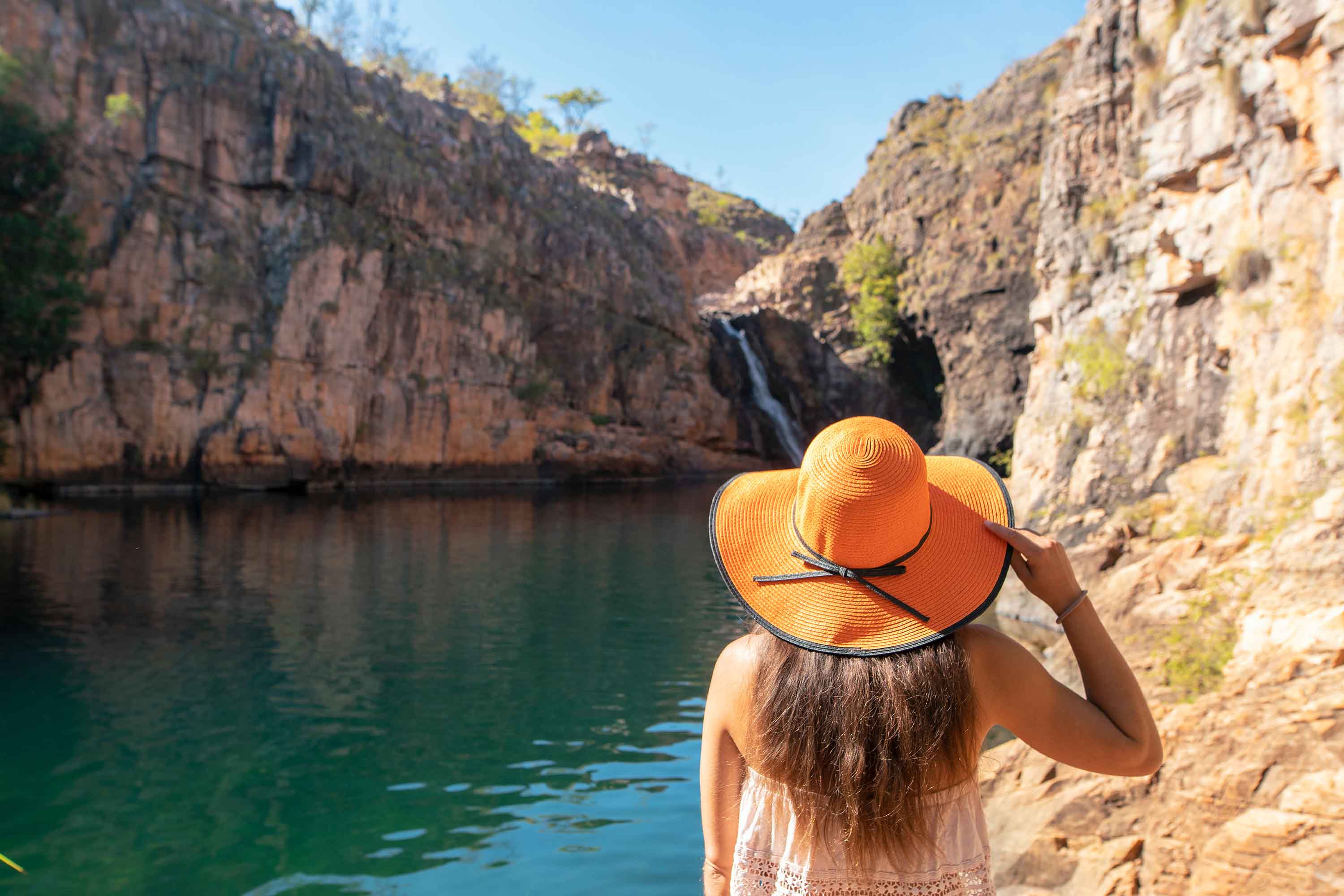
Twin Falls
Open every day, weather permitting, with a tour fee. Twin Falls, nestled in the Arnhem Land escarpment, offers a unique experience. Begin with a ranger-led boat cruise, followed by a bushwalk and a leisurely journey along a boardwalk leading to the stunning falls. The panoramic vistas of the red escarpment and shimmering waters are a sight to behold. Conclude your visit by relaxing on the pristine white sandy shore.
Ubirr, situated 40 kilometers from Jabiru, is accessible daily depending on road conditions. As one of the two most renowned rock art galleries in Kakadu National Park, Ubirr’s ancient artwork can be explored via an easy one-kilometer loop walking track. In the dry season, Park Rangers host complimentary talks, shedding light on these historic rock paintings. A moderately challenging 250-meter ascent leads to a rocky vantage point offering expansive views over the floodplains. Watching a breathtaking tropical sunset from Ubirr’s summit is an experience not to be missed. Visitors are kindly reminded by the Traditional Owners of Ubirr that the consumption of alcohol is not permitted at this site.
Yellow Water Billabong
Open every day, Yellow Water stands as a signature attraction of Kakadu National Park. Situated near the quaint settlement of Cooinda, this billabong is a thriving habitat for crocodiles, wild horses, buffalo, and a variety of other wildlife. During the wet season, Yellow Water expands to join with other waterways, drawing millions of migratory birds annually. This includes species such as jacanas, egrets, jabirus, sea eagles, and magpie geese. The banks are adorned with paperbark forests, pandanus, and freshwater mangroves, while the water’s surface is beautified by pink and white waterlilies. Discover the wonders of this billabong by taking a wildlife cruise, or experience a spectacular sunset from the dedicated viewing platform.
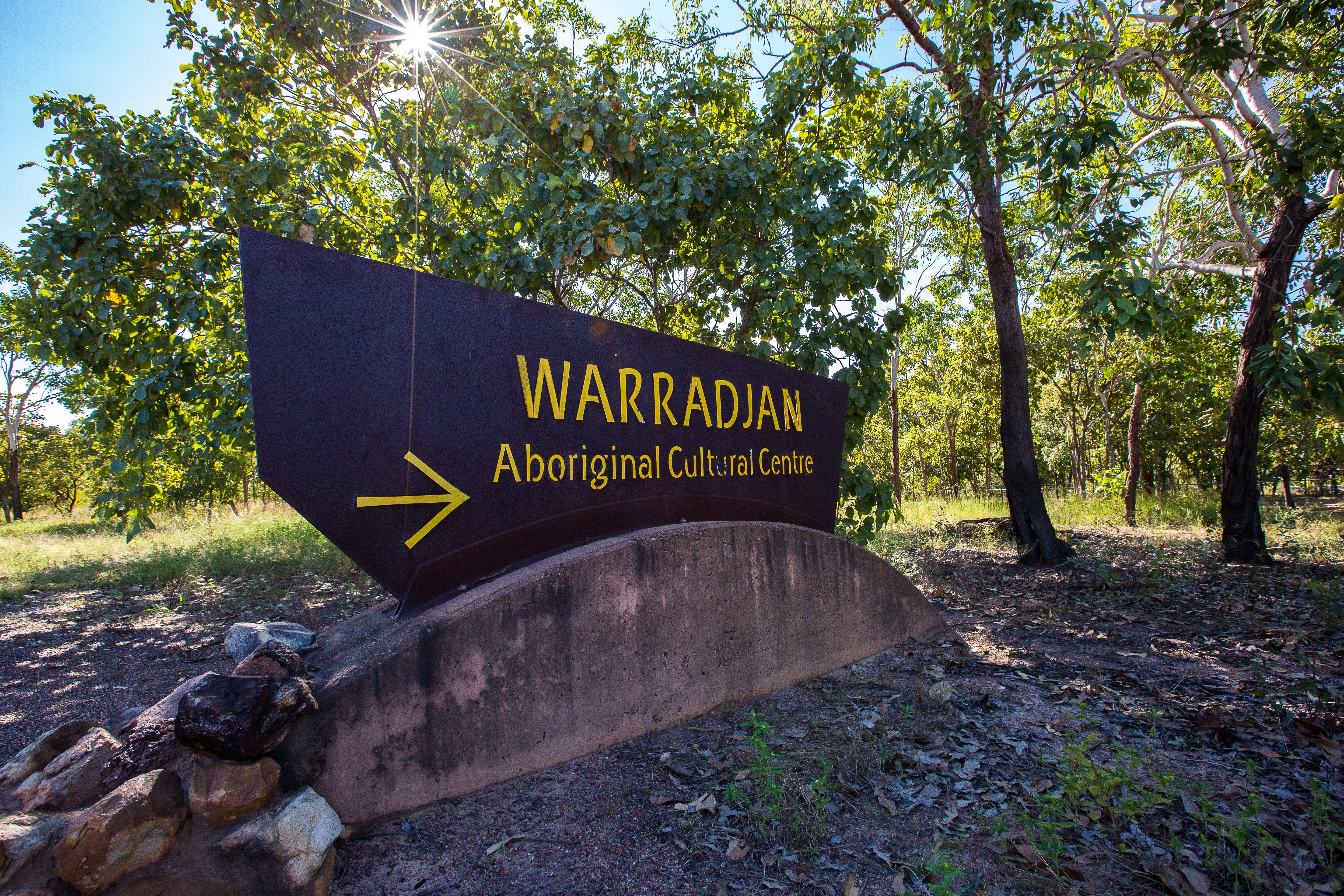
Warradjan Aboriginal Cultural Centre
Located 4.5 kilometers off the Kakadu Highway en-route to Cooinda and is Ooen daily with free entry. To understand something of the connection Kakadu’s Aboriginal owners have with this special part of the Top End, spend some time at the Warradjan Cultural Centre learning the stories that gave them their laws. Aboriginal people developed this center so they could share their culture. The building has been styled in the shape of a pig nosed turtle, Warradjan, and is based on the theme ‘our land is our life’. Allow at least an hour to view and appreciate this attraction.
Savannah Way
The Epic Savannah Way stretches from coast to coast from Broome in the North West of Western Australia to Cairns in North Eastern Queensland through the heart of the outback. The Savannah Way is a 3700 kilometre trek across the Top End of Australia and is an excellent length for a 14 day or 90 day adventure across Northern Australia. The route is designed to also accommodate shorter trips with linkages to many other themed routes like Matilda, Overlander’s and Explorer’s Highways and has the potential for fly and drive options. The 3700 kilometre route links 15 National Parks and 5 World Heritage areas. You can explore just a section or cross the continent enjoying its wide horizons, ancient gorges and abundant wildlife, connecting with Aboriginal and pioneer heritage in today’s friendly outback.
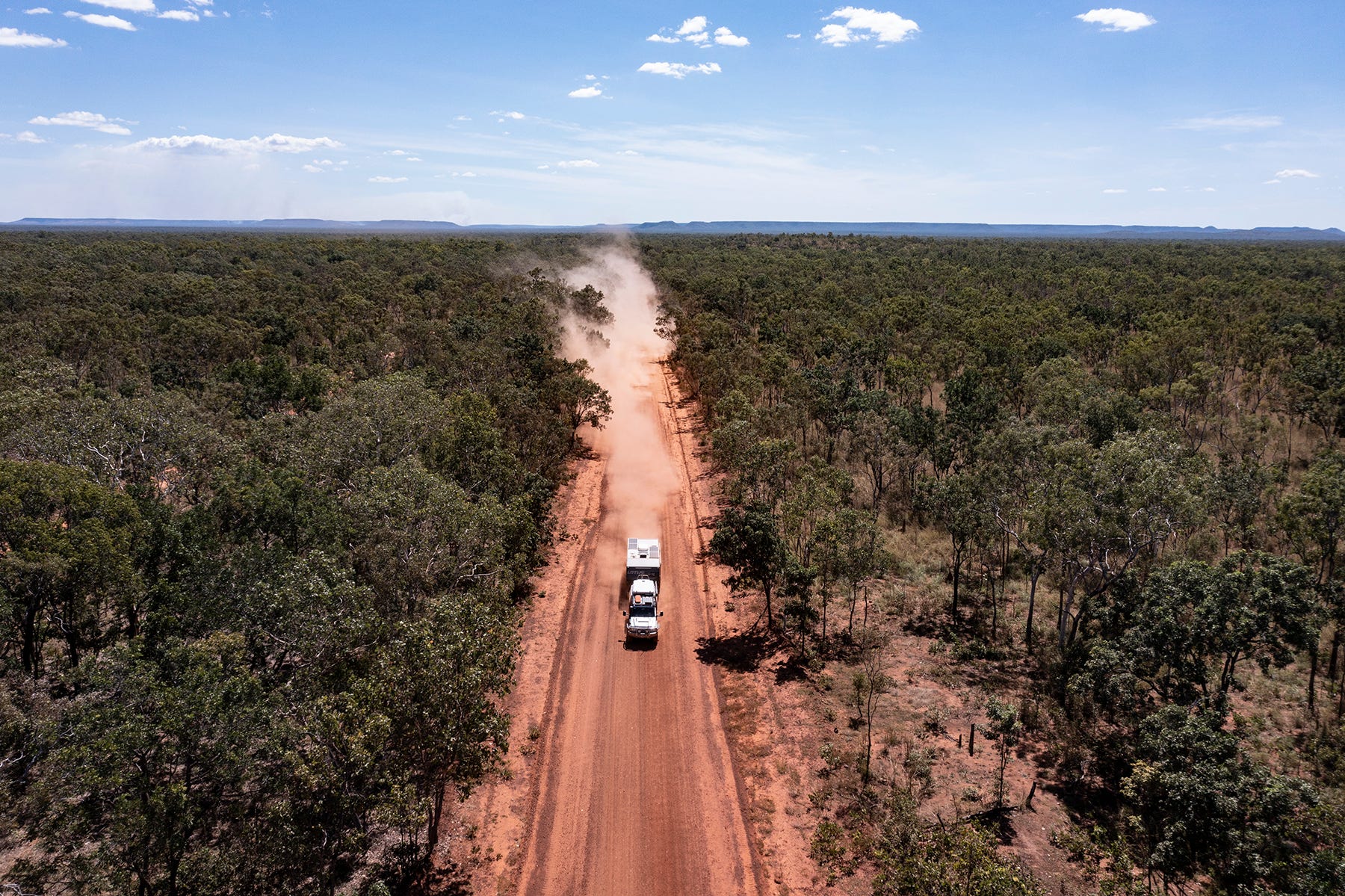

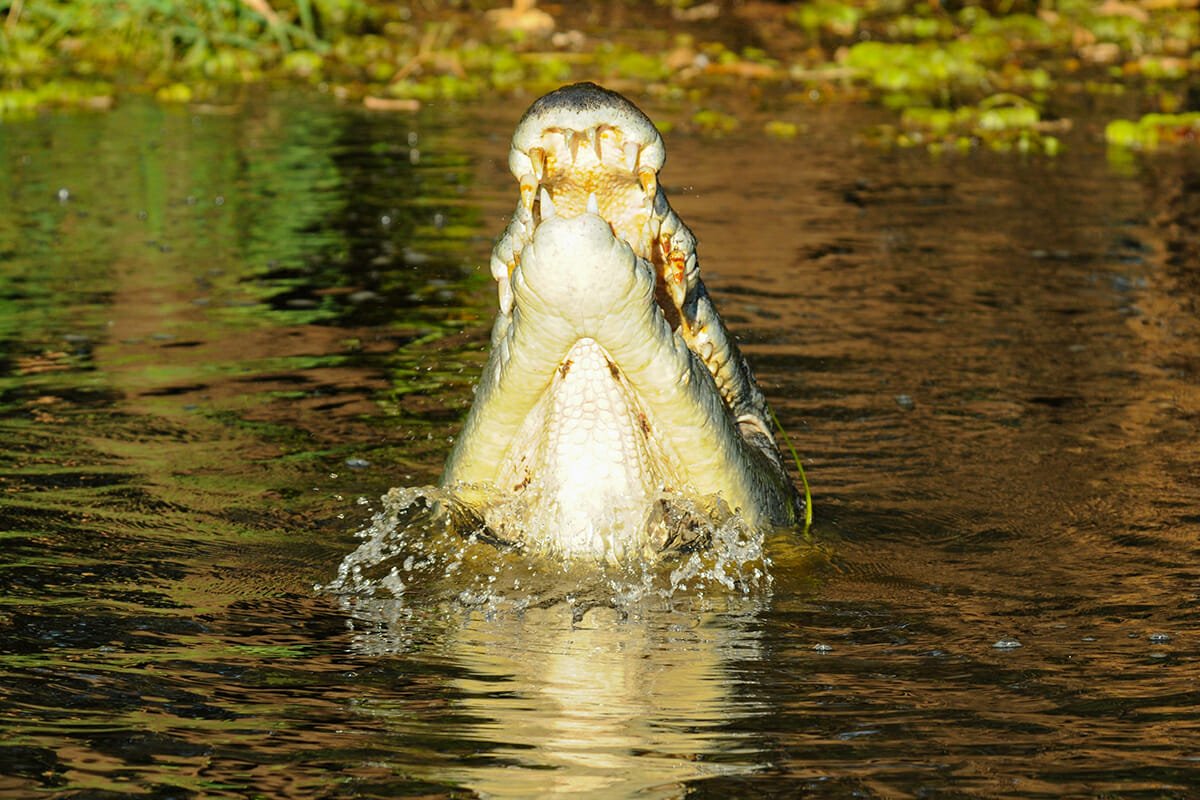

Kakadu 4WD Hire
Camperworld 4WD Hire offers well-equipped four-wheel drives perfect for self-drive touring, giving you the freedom to explore at your own pace. Start your adventure in Darwin and embark on the Nature’s Way adventure route, a journey that’s a visual feast for every traveler. This scenic route winds through the breathtaking Litchfield National Park, onwards to the World Heritage-listed Kakadu National Park, and through the picturesque Nitmiluk National Park. This drive takes you through the lush northern tropics of the Territory, rich in natural beauty, Aboriginal culture, and outback pioneering history. Along the way, enjoy swimming in the waterfalls and rock pools of Litchfield, canoeing down the Katherine River, and exploring the world’s most extensive collection of Aboriginal rock art in Kakadu. While you can set your own schedule, allotting 7 to 14 days for this journey is ideal to fully experience the splendors of this incredible route.
In the Outback, certain road sections are navigable only with 4WD vehicles. It’s crucial to carry ample water for all Outback excursions. Always check the distances and driving conditions, and ensure your vehicle has sufficient fuel for the journey. Adhere to the essential Outback Rule “Number 1”: in case of a vehicle breakdown, it’s imperative for safety reasons to stay with your vehicle. Driving times are significantly longer on unsealed roads when using a 4WD, so make sure to plan accordingly to avoid delays. Be aware that during the ‘wet season’, from October to April, 4WD-only and unsealed roads may be inaccessible. To prevent any letdowns, it’s advisable to plan your itinerary well in advance.
The Top End’s expansive wilderness and warm climate make it an ideal setting for caravan and 4WD camping holidays. The peak season runs from May to September, so it’s wise to book early to secure your spot. Begin planning your adventure with a 4WD hire from Darwin in Kakadu National Park, then journey straight across Australia to Alice Springs and Adelaide. Alternatively, embark on a scenic drive along the Savannah Way towards Broome, taking in Australia’s north-western landscapes. En route, paddle down Katherine Gorge and soar above the unique, beehive-shaped Bungle Bungles in Western Australia’s Kimberley Region. From Darwin, take the Nature’s Way to explore the dual World Heritage-listed Kakadu National Park, recognized for its cultural and natural treasures. Venture to Uluru, Kings Canyon, and other iconic attractions from the outback base of Alice Springs. Adelaide, with its elegance and charm, serves as the perfect starting point for visiting the Barossa Valley, Flinders Ranges, the Fleurieu Peninsula, and the natural paradise of Kangaroo Island.
National Parks offer well-equipped camp areas, often with onsite rangers, and designated spaces for both generator and non-generator use. These sites typically feature fresh water, toilets, and shower facilities. Be aware that there may be limits on the duration of your stay, and park fees could apply. For detailed information about camping in national parks, including site specifics and associated fees, visit the Parks and Wildlife Commission NT website.
Given the vast distances between townships in these regions, you might find yourself needing to camp on private properties or Aboriginal lands. It’s crucial to secure permission and any necessary permits before entering these areas. Be mindful that some roads may not be suitable for towing caravans, and there are camping restrictions in certain regions. Always check the latest road conditions and understand the permit requirements with the local Park Management before embarking on your journey.
For additional travel advice and guidelines, visit Parks and Wildlife NT.
Welcomes you to explore one of the most pristine places on the planet.
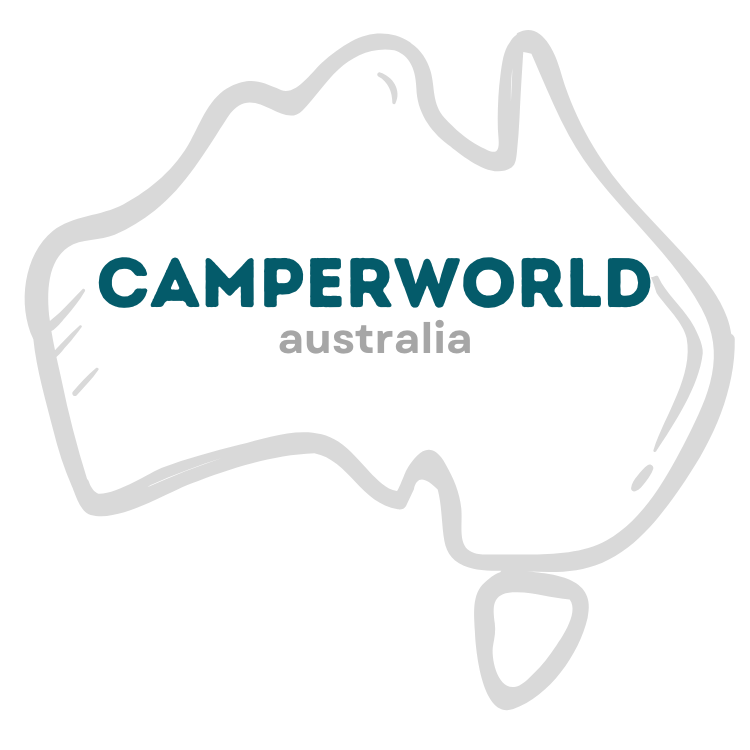

No comment yet, add your voice below!